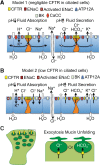Viral Vectors, Animal Models, and Cellular Targets for Gene Therapy of Cystic Fibrosis Lung Disease
- PMID: 32138545
- PMCID: PMC7232698
- DOI: 10.1089/hum.2020.013
Viral Vectors, Animal Models, and Cellular Targets for Gene Therapy of Cystic Fibrosis Lung Disease
Abstract
After more than two decades since clinical trials tested the first use of recombinant adeno-associated virus (rAAV) to treat cystic fibrosis (CF) lung disease, gene therapy for this disorder has undergone a tremendous resurgence. Fueling this enthusiasm has been an enhanced understanding of rAAV transduction biology and cellular processes that limit transduction of airway epithelia, the development of new rAAV serotypes and other vector systems with high-level tropism for airway epithelial cells, an improved understanding of CF lung pathogenesis and the cellular targets for gene therapy, and the development of new animal models that reproduce the human CF disease phenotype. These advances have created a preclinical path for both assessing the efficacy of gene therapies in the CF lung and interrogating the target cell types in the lung required for complementation of the CF disease state. Lessons learned from early gene therapy attempts with rAAV in the CF lung have guided thinking for the testing of next-generation vector systems. Although unknown questions still remain regarding the cellular targets in the lung that are required or sufficient to complement CF lung disease, the field is now well positioned to tackle these challenges. This review will highlight the role that next-generation CF animal models are playing in the preclinical development of gene therapies for CF lung disease and the knowledge gaps in disease pathophysiology that these models are attempting to fill.
Keywords: animal models; cellular targets; cystic fibrosis; gene therapy; pathophysiology; viral vectors.
Conflict of interest statement
Z.Y. and J.F.E. receive income for consulting with Spirovant Science. J.F.E. has sponsored research with Vertex Pharmaceuticals and Spirovant Science.
Figures


Similar articles
-
Species-specific differences in mouse and human airway epithelial biology of recombinant adeno-associated virus transduction.Am J Respir Cell Mol Biol. 2006 Jan;34(1):56-64. doi: 10.1165/rcmb.2005-0189OC. Epub 2005 Sep 29. Am J Respir Cell Mol Biol. 2006. PMID: 16195538 Free PMC article.
-
Factors influencing adeno-associated virus-mediated gene transfer to human cystic fibrosis airway epithelial cells: comparison with adenovirus vectors.J Virol. 1998 Nov;72(11):8904-12. doi: 10.1128/JVI.72.11.8904-8912.1998. J Virol. 1998. PMID: 9765435 Free PMC article.
-
rAAV-CFTRΔR Rescues the Cystic Fibrosis Phenotype in Human Intestinal Organoids and Cystic Fibrosis Mice.Am J Respir Crit Care Med. 2016 Feb 1;193(3):288-98. doi: 10.1164/rccm.201505-0914OC. Am J Respir Crit Care Med. 2016. PMID: 26509335
-
Advances in gene therapy for cystic fibrosis lung disease.Hum Mol Genet. 2019 Oct 1;28(R1):R88-R94. doi: 10.1093/hmg/ddz139. Hum Mol Genet. 2019. PMID: 31332440 Free PMC article. Review.
-
Recombinant adeno-associated virus vectors for cystic fibrosis gene therapy.Curr Opin Mol Ther. 2001 Oct;3(5):497-502. Curr Opin Mol Ther. 2001. PMID: 11699895 Review.
Cited by
-
Advancing the Battle against Cystic Fibrosis: Stem Cell and Gene Therapy Insights.Curr Med Sci. 2024 Dec;44(6):1155-1174. doi: 10.1007/s11596-024-2936-5. Epub 2024 Dec 16. Curr Med Sci. 2024. PMID: 39676146 Review.
-
Cell-Based Therapeutic Approaches for Cystic Fibrosis.Int J Mol Sci. 2020 Jul 23;21(15):5219. doi: 10.3390/ijms21155219. Int J Mol Sci. 2020. PMID: 32718005 Free PMC article. Review.
-
An optimized HEK293T cell expansion protocol using a hollow-fiber bioreactor system.Biol Methods Protoc. 2023 Sep 13;8(1):bpad018. doi: 10.1093/biomethods/bpad018. eCollection 2023. Biol Methods Protoc. 2023. PMID: 37720517 Free PMC article.
-
Recombinant Adeno-Associated Virus-Mediated Editing of the G551D Cystic Fibrosis Transmembrane Conductance Regulator Mutation in Ferret Airway Basal Cells.Hum Gene Ther. 2022 Oct;33(19-20):1023-1036. doi: 10.1089/hum.2022.036. Epub 2022 Aug 4. Hum Gene Ther. 2022. PMID: 35686451 Free PMC article.
-
Detargeting Lentiviral-Mediated CFTR Expression in Airway Basal Cells Using miR-106b.Genes (Basel). 2020 Oct 6;11(10):1169. doi: 10.3390/genes11101169. Genes (Basel). 2020. PMID: 33036232 Free PMC article.
References
-
- Riordan JR, Rommens JM, Kerem B, et al. . Identification of the cystic fibrosis gene: cloning and characterization of complementary DNA. Science 1989;245:1066–1073 - PubMed
-
- Kunzelmann K, Schreiber R, Hadorn HB. Bicarbonate in cystic fibrosis. J Cyst Fibros 2017;16:653–662 - PubMed
-
- Wine JJ, Hansson GC, Konig P, et al. . Progress in understanding mucus abnormalities in cystic fibrosis airways. J Cyst Fibros 2018;17:S35–S39 - PubMed
-
- Zhou-Suckow Z, Duerr J, Hagner M, et al. . Airway mucus, inflammation and remodeling: emerging links in the pathogenesis of chronic lung diseases. Cell Tissue Res 2017;367:537–550 - PubMed
Publication types
MeSH terms
Substances
Grants and funding
LinkOut - more resources
Full Text Sources
Medical

